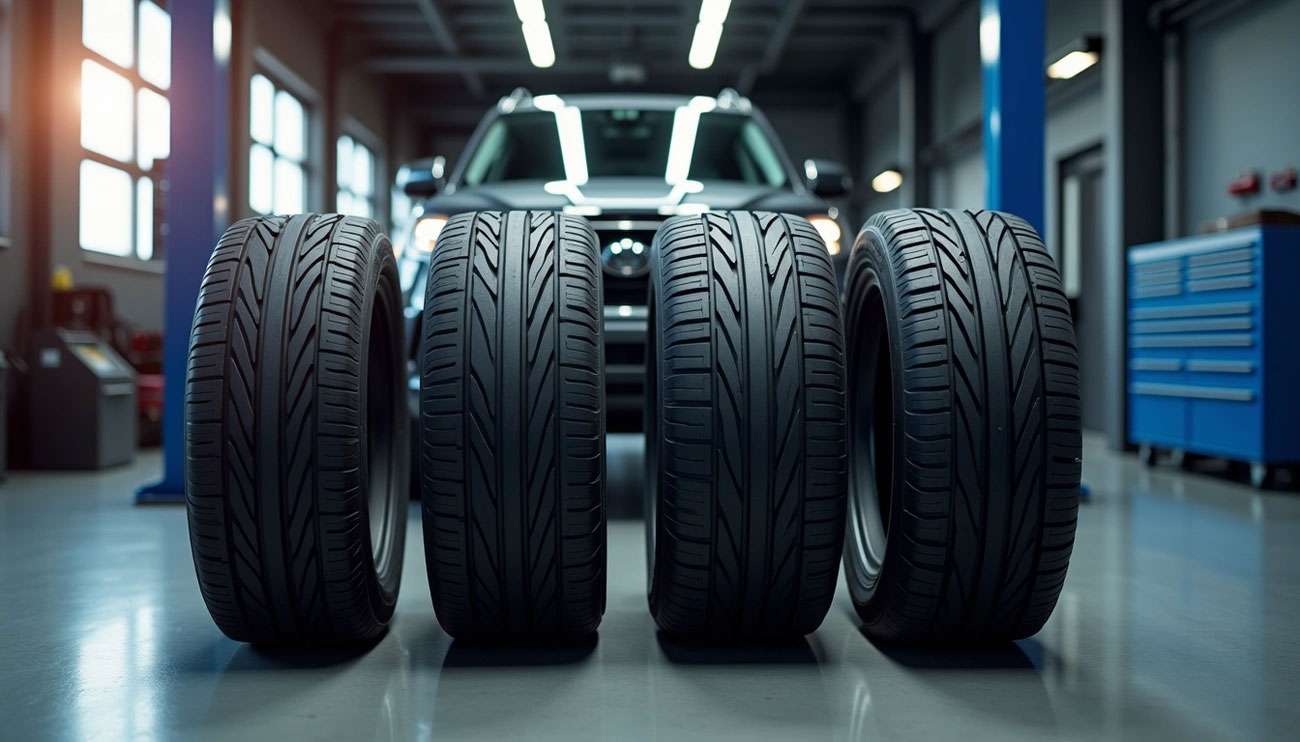
When it comes to tire replacement costs, the price range can be staggering - from as little as $50 to over $1,000 per tire. This wide variation often catches vehicle owners off guard when they're suddenly faced with a tire replacement decision.
For the average driver, a complete set of four new tires typically costs between $460 and $1,280. Recent Consumer Reports surveys show a median price of $223 per tire in 2023. Installation adds to your tire replacement cost, with median installation prices rising from $25 to $31 per tire in recent years.
Tire prices have been climbing steadily. Back in 2020, drivers paid a median price of $167 per tire, which increased to $194 in 2022, and continues to rise. When you consider that over 500 people were killed in tire-related crashes in the U.S. in 2022, understanding when to invest in new tires becomes not just a financial decision but a safety imperative.
Whether you're shopping for standard tires for a small vehicle ($200-$500 for a set of four) or large premium tires that can reach up to $2,500 for a complete set, this guide will help you understand what factors affect how much a new set of tires costs. We'll help you make the best choice for your vehicle and budget while ensuring you get the performance and safety you need.
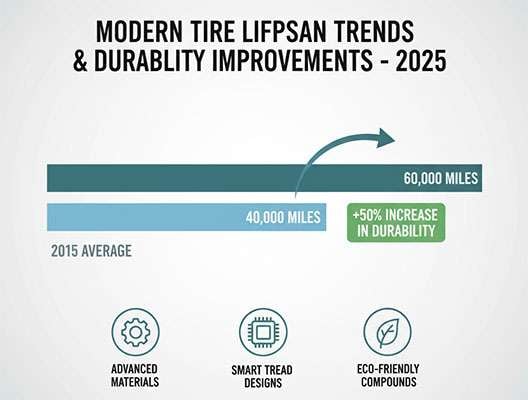
Understanding tire lifespan helps you prepare for future expenses, especially since tire replacement represents a significant vehicle maintenance cost. New technologies in 2025 are extending how long modern tires last, potentially reducing your long-term expenses.
Tire durability continues to improve in 2025, with significant advancements in tread compounds and design. Extensive testing shows that family-car tires can readily last 70,000 miles or more, particularly with all-season and performance all-season models. High-scoring all-season tires typically deliver between 55,000 to 85,000 miles of service, while performance all-season tires offer between 50,000 and 85,000 miles.
The newest tire models show notable improvements. The Michelin e.Primacy All Season tire, released in February 2025, shows an estimated life of 45,764 miles in Federal Highway Administration tests—approximately 13,000-15,000 miles more than its main competitors. Bridgestone's new W920 commercial tire offers 18% longer tread life compared to its predecessor.
Most quality all-terrain tires now deliver between 45,000 to 65,000 miles for passenger vehicles, with some premium models pushing past 80,000 miles under ideal conditions. Ultra-high-performance tires wear more quickly, typically lasting only 25,000 to 30,000 miles.
A good quality all-season tire lasts between three and five years for drivers covering 12,000 to 15,000 miles annually. However, even minimally used tires should be monitored for aging rather than just wear.
Several key factors determine how quickly your tires wear out, regardless of quality:
Vehicle Type and Weight: Heavier vehicles place more stress on tires. Electric vehicles, which tend to be heavier than comparable internal combustion models due to their batteries, often require more frequent tire replacements. Tire wear varies by drivetrain type—all-wheel drive vehicles may experience faster overall tire wear than front-wheel or rear-wheel drive vehicles.
Tire Position: Front tires typically wear out faster (around 20,000 miles) than rear tires (up to 40,000 miles) due to steering forces. This disparity is especially noticeable in front-wheel drive vehicles where the front tires handle both steering and power delivery.
Tire Width and Design: Wider tires create a larger contact patch with the road, which can reduce ground pressure and potentially decrease wear—provided you don't drive aggressively. Performance tires with softer compounds deliver better grip but wear more quickly than standard all-season tires.
Road Conditions: Driving regularly on rough surfaces like gravel roads, construction zones, or unpaved areas accelerates tire wear significantly. Hilly terrain also increases wear due to the additional power needed to climb and the increased braking required for descents.
Driving Style: Perhaps the most significant factor within your control is driving behavior. Hard acceleration, aggressive braking, and fast cornering can reduce tire life by as much as half—sometimes even more. Aggressive drivers consistently saw significantly shorter tire lifespans across every brand compared to those with smoother habits.
Weather Conditions: Extreme temperatures affect tire compounds. Summer tires wear more quickly in temperatures below 45°F, while winter tires deteriorate faster above that temperature. UV exposure from direct sunlight also breaks down rubber compounds over time.
Proper maintenance can dramatically extend tire life—or cut it short when neglected:
Regular Rotation: Rotating tires every 5,000-8,000 miles ensures even wear distribution. For front-wheel drive vehicles, moving front tires to the same positions at the rear (and rear tires diagonally to the front) balances wear patterns. Without rotation, some tires may wear out twice as fast as others.
Proper Inflation: Underinflated tires flex more, generating heat and wearing out at the edges, while overinflated tires wear more quickly in the center. Monthly pressure checks can extend tread life significantly—proper inflation alone can add approximately 4,700 miles to your tire's lifespan.
Wheel Alignment and Balancing: Misaligned wheels cause uneven tire wear and reduce handling. Signs that your wheels need alignment include your vehicle pulling to one side, steering wheel vibration, or unusual wear patterns. Unbalanced tires lead to vibrations and premature wear.
Driving Habits Adjustment: Simple changes like accelerating smoothly, braking gradually, and taking corners at controlled speeds significantly reduce tire stress. Maintaining safe following distances allows for more gradual braking, further preserving tread life.
Regular Inspections: Monthly visual checks for damage, foreign objects, and wear patterns help catch problems early. The penny test (inserting a penny with Lincoln's head pointing down into the tread groove) remains a reliable way to check tread depth—if you can see all of Lincoln's head, it's time for replacement.
Tire manufacturers recommend replacement after 10 years due to natural rubber degradation that compromises safety. Even tires that look good externally may have weakened structural integrity.
Consistent maintenance and mindful driving can maximize the value of your tire investment and reduce how often you face new tire costs.
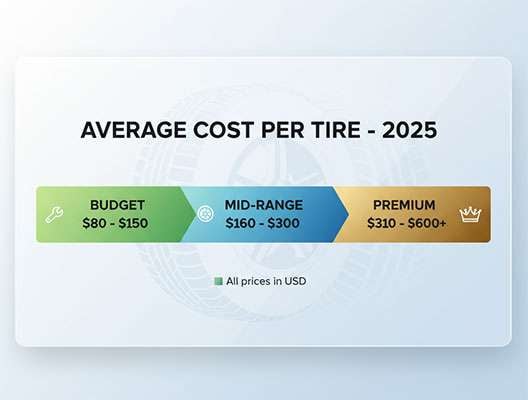
New tires represent a significant vehicle maintenance expense in 2025. With industry figures showing substantial price variations, understanding the current market helps you make informed decisions about this essential purchase.
The size and type of your vehicle directly impact how much you'll pay for new tires. Smaller vehicles typically require less expensive tires, while larger vehicles like SUVs and trucks demand pricier options.
For sedans and compact cars with 12- to 15-inch tires, expect to pay between $80 and $150 per tire. These smaller sizes remain the most economical option for everyday drivers. Medium-sized vehicles with 16- to 20-inch tires (common on modern sedans, SUVs, and some trucks) typically range from $100 to $400 per tire.
Owners of larger vehicles face the steepest costs. SUVs, trucks, and campers requiring 18- to 26-inch tires typically see prices between $140 and $500 per tire. This substantial price difference reflects both the increased material costs and specialized manufacturing requirements.
Electric vehicles often require specialized tires designed to handle their unique weight distribution and torque characteristics. EV-specific tires generally cost between $180 and $290 each, representing a premium over conventional options.
The pricing landscape varies dramatically between budget and premium options:
| Tire Category | Price Range Per Tire |
| Economy/Budget | $65-$100 |
| Mid-range | $100-$160 |
| Premium | $160-$350 |
Premium tires typically offer substantially longer tread life—often 50,000 to 70,000 miles compared to 30,000 to 40,000 miles for budget options. Despite the higher initial cost, premium tires may represent better long-term value.
When facing tire damage, vehicle owners must decide between repair and replacement. Minor issues like small punctures typically cost between $20 and $50 to repair. More complex repairs start at approximately $100.
Basic patching or plugging runs $20 to $50, while complete flat tire repairs generally cost $50 to $100. Bead damage (the part of the tire that grips the rim) can cost $50 to $150 to repair.
There comes a point where replacement becomes the more economical choice. Even though a tire patch might cost only $10 to $50, its effectiveness depends entirely on the damage location and severity.
The economics become clearer when comparing total lifecycle costs. Repairing may save money initially, but compromised tires often wear faster, reduce fuel efficiency, and may require earlier replacement. Some damages—particularly to sidewalls—simply cannot be safely repaired at any price.
Need help finding the right balance between cost and quality? Find your new tires with trusted professionals who can help evaluate your specific situation.
The industry average price paid for a single tire stands at $192. A complete set of four tires costs approximately $768 before installation and additional fees.
Prices vary dramatically across the market. For a complete set of four tires, most consumers should budget between $460 and $1,280. This wide range reflects significant differences in tire types, sizes, and quality tiers.
All-season tires, the most versatile and common option, range from $50 to $870 per tire, making a complete set cost approximately $200 to $3,480. Winter tires cost between $60 and $1,310 per tire, with a full set ranging from $240 to $5,240. Summer tires typically cost more, ranging from $80 to $1,490 per tire, meaning a complete set costs between $320 and $5,960.
Installation adds considerably to the final price. Labor costs for mounting and balancing typically run between $50 and $300 for a complete set. This varies based on your location and the complexity of your vehicle's requirements.
Additional costs often overlooked include:
These supplementary services can add $75 to $200 to your total, making comprehensive budgeting essential.
Most tire retailers offer discounts across the category, with the average discount being approximately 14%. This discount trend reflects the market's response to inflation concerns and tariff-induced cost pressures.
Tire prices have been trending upward. Industry reports show increases in raw material costs have pushed tire prices between 5% and 10% higher in recent years. This could mean an additional $100 or more for premium tires for typical vehicles.
For budget-conscious consumers, standard all-season tires (15-16") typically cost between $90 and $150 each. Performance all-season options (17-18") run approximately $140 to $220 per tire, while specialized tires like run-flats (17-19") command $180 to $350 each.
Understanding these cost factors helps you make informed decisions that balance immediate budget concerns with long-term safety and performance considerations.
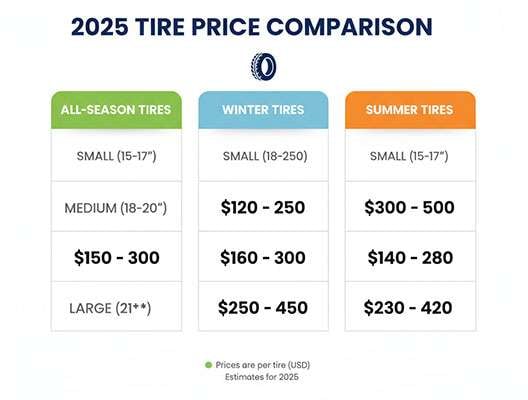
Tire prices vary dramatically based on type and size in 2025, with options ranging from budget-friendly everyday tires to specialized high-performance models. Understanding exactly what you can expect to pay based on your specific needs and vehicle requirements helps you make the right choice for your situation.
All-season tires remain the most popular choice for everyday drivers, offering a balance between performance, longevity, and cost. Budget all-season tires typically cost between $50.00 and $150.00 per tire. Entry-level options, including brands like Accelera, Delinte, and Zeetex, start as low as $46.00 per tire.
Mid-range all-season tires deliver improved performance and longer tread life, costing between $100.00 and $300.00 per tire. This category includes respected options like the Continental TrueContact Tour (starting at $105.00) and the Kumho Solus TA31 (from $102.00).
For drivers seeking premium quality, top-tier all-season tires from manufacturers like Michelin and Bridgestone range from $300.00 to $1000.00 per tire. The Michelin Defender T+H starts at $190.00, while the Bridgestone Turanza QuietTrack begins at $180.00.
Your tire size significantly impacts pricing. Common sizes like 195/65R15 start at $50.00, whereas larger sizes such as 275/60R20 begin around $130.00.
Winter tires, specifically designed for cold weather performance, typically command higher prices than comparable all-season options. A complete set of four studded winter tires costs between $250.00 and $1,500.00, depending on size and brand. Studless winter tires for typical compact cars range from $250.00 to $600.00, while SUV or pickup truck winter tires cost between $600.00 and $1,500.00.
Summer tires offer superior dry and wet weather grip at higher temperatures. Performance summer tires typically start at higher price points than all-season equivalents, with entry-level options beginning around $80.00 per tire and premium models reaching up to $1,490.00 each.
Some winter tires cost as little as $50.00 or as much as $100,000 for specialized models. Installation adds between $50.00 and $300.00 for mounting and balancing a complete set.
Find your new tires with options that match both your vehicle's requirements and regional weather conditions for optimal performance and safety.
Performance tires, engineered for enhanced handling and grip, represent a premium segment in the market. The Michelin Pilot Sport 4 S, a top-rated performance tire, starts around $233.00 per tire. Other performance options like the Goodyear Eagle F1 Asymmetric 6 range from $153.00 to $975.00 depending on size.
Off-road tires present an equally wide pricing spectrum. Off-road tires typically cost between $150.00 and $750.00 per tire, with custom options potentially exceeding $100,000 each. Entry-level all-terrain tires start between $150.00 and $250.00, while premium all-terrain models range from $400.00 to $600.00. Specialized mud-terrain tires typically cost $300.00 to $750.00, and rock-crawling tires range from $350.00 to $800.00.
Several factors influence performance and off-road tire pricing:
| Factor | Impact on Price | Examples |
| Tire Type | High | Mud tires cost more than all-terrain |
| Size | High | Larger sizes have higher material costs |
| Brand | Medium to High | Premium brands command higher prices |
| Materials | Medium | Advanced compounds increase cost |
| Ratings | High | Special certifications add premium |
Premium tire options often incorporate advanced technology and specialized materials that justify their higher prices. The Pirelli P Zero PZ5, a high-performance option, costs between $332.13 and $529.02 per tire. The Bridgestone Potenza Sport ranges from $175.99 to $682.99 depending on size.
Wheel choices affect your total cost. Steel wheels remain the most economical option, while alloy wheels command higher prices due to their lighter weight and aesthetic appeal. Larger wheel diameters cost more due to additional materials and engineering required.
Industry experts forecast tire price increases throughout 2025, primarily driven by rising raw material costs (rubber prices increased 80% between April 2020 and April 2021), ongoing supply chain challenges, and economic inflation. Even standard tire options have seen price adjustments that budget-conscious shoppers should consider.
Installation services add to the overall expense. Tire balancing typically costs between $37.00 and $55.00 per tire, though many retailers offer mounting, balancing, and installation hardware at no additional charge when purchasing complete wheel and tire packages.
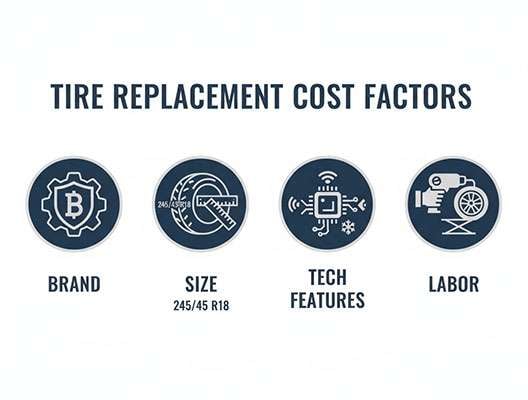
Several key factors influence your tire replacement cost beyond just the basic tire type. Understanding these elements helps you make informed decisions when budgeting for this essential vehicle maintenance expense.
Brand reputation substantially impacts what you'll pay for new tires. Premium manufacturers like Michelin, Bridgestone, and Continental typically command higher prices, often costing twice as much as comparable budget options. Michelin, consistently rated among the top performers in most categories, offers excellent grip, handling, and long tread life—justifying their premium pricing.
The price variation between brands stems primarily from:
Tire prices continue their upward trend in 2025, with average costs rising 21.4% over just two years—substantially outpacing core inflation. A tire previously priced at $100 now costs approximately $120, while premium options formerly at $250 have jumped to $300 or more.
Tire size represents one of the most significant pricing factors. As tire size increases, so does the price—consistently across all brands and types.
This size-to-price relationship exists because:
Tires for large trucks, pickup trucks, and sports cars typically cost twice as much as those of similar material composition made for small passenger cars. Smaller vehicles with 15" to 18" wheels generally use more affordable tires than those requiring 19" to 22" or larger sizes.
Advanced tire technologies add significant value yet invariably increase prices. Self-sealing technology—where a polymer layer inside the tire acts like "super-strong glue" to fill punctures automatically—adds substantial cost but allows continued driving after running over nails.
Other price-influencing technologies include:
These innovations address seemingly contradictory requirements—tires now need minimal friction for fuel efficiency yet maximum friction for emergency braking. This engineering complexity inevitably raises production costs and retail prices.
The complete expense of new tires extends beyond just the tire cost. Installation services add significantly to your total investment. At major retailers like Goodyear, standard installation for four tires costs approximately $99.80, including mounting, balancing, and TPMS (Tire Pressure Monitoring System) kit.
Installation includes crucial services:
Improperly mounted tires can lead to dangerous tire failures, while poorly balanced wheels cause vibrations that damage both tires and suspension components. Professional installation represents an essential safety investment rather than an optional add-on.
Some retailers include additional perks with installation, potentially offering free tire rotation, balance checks, or flat tire repairs throughout the tire's lifetime—services that would otherwise add to long-term ownership costs.
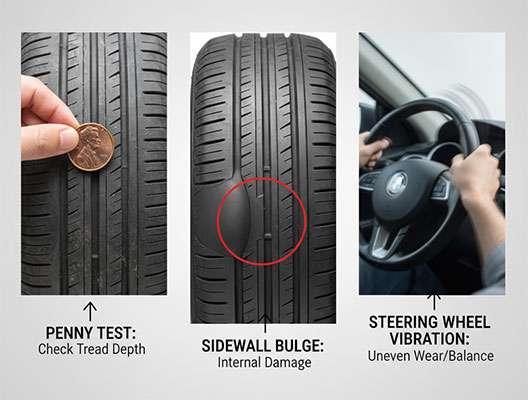
Knowing when your tires need replacement is crucial for both safety and budget planning. Tires that are past their prime can cost you more in fuel and pose serious safety risks. Here are the key indicators that it's time to invest in new tires.
Tires in the United States typically start with 10/32" or 11/32" of tread depth. As this wears down, your tire's ability to perform safely diminishes. The Department of Transportation recommends replacement at 2/32" of tread depth, which is legally mandated in most states.
The penny test remains reliable for checking your tread depth. Insert a penny with Lincoln's head facing downward into the tread groove. If you can see the top of Lincoln's head, your tread is worn to 2/32" or less, indicating immediate replacement is necessary. For added safety, many experts recommend using the quarter test instead—if Washington's head is visible, your tread is at 4/32" or less, which is when stopping distances begin to deteriorate significantly.
Unexplained vibrations in your steering wheel, particularly at speeds of 40 mph or higher, often indicate tire imbalance. This might result from losing a wheel weight, mechanical brake problems, or uneven tread wear.
When your vehicle pulls to one side or exhibits poor handling, you likely need a wheel alignment. These symptoms can accelerate tire wear and potentially lead to dangerous driving conditions.
Tire bubbles or bulges on the sidewall signal serious internal damage. Unlike a bruise, a tire bubble doesn't heal and indicates compromised internal structure. Even small bubbles should be treated as emergencies—they allow air to seep into the tire, increasing the risk of a blowout at any moment.
Other visual warning signs include cracking or cuts in sidewalls and excessive or uneven tread wear. These conditions require immediate professional evaluation.
Worn tires can significantly impact your vehicle's fuel economy. Underinflated tires can reduce gas mileage by up to 3% due to increased rolling resistance. As tread wears, rolling resistance changes—brand new tires with deeper treads may initially decrease fuel economy before stabilizing as they wear slightly.
The most critical impact involves safety. Research reveals that relatively worn tires can increase wet-weather stopping distances by a staggering 43%—adding 87 feet, more than a semi-trailer's length, compared to new tires. Tire performance capabilities decrease substantially once tread depth drops to 4/32", making tires unsuitable for wet or snowy conditions.
We recommend monthly tread depth checks, particularly before long trips, to ensure your tires remain safe and effective.
Understanding tire costs requires looking at multiple factors that work together to determine your total investment. This reference table breaks down the key elements that affect your tire buying decisions, helping you budget effectively for this essential vehicle maintenance expense.
| Topic | Typical Cost Range | Key Factors/Characteristics | Recommended Timeline/Duration | Notable Statistics/Data |
| Tire Lifespan | N/A | Vehicle type, tire position, road conditions, driving style, weather conditions, maintenance | 3-5 years for average drivers (12,000-15,000 miles annually) | All-season tires: 55,000-85,000 miles; Performance tires: 25,000-30,000 miles |
| Average Cost | $460-$1,280 (set of four) | Vehicle size, tire quality tier, installation costs | N/A | Median price: $223 per tire (2023); Installation: $25-$31 per tire |
| Tire Types & Sizes | All-season: $50-$870 per tire; Winter: $60-$1,310 per tire; Summer: $80-$1,490 per tire | Tire size, brand quality, specialized features, vehicle type | N/A | Small vehicles (12-15"): $80-$150 per tire; Medium (16-20"): $100-$400 per tire; Large (18-26"): $140-$500 per tire |
| Cost Factors | Installation: $50-$300 per set | Brand reputation, tire size, technology features, labor charges | N/A | Price increases of 21.4% over two years; Premium brands cost twice as much as budget options |
| Replacement Signs | N/A | Tread wear, vibrations, visual damage, fuel efficiency changes | Replace at 2/32" tread depth (legal minimum) | Worn tires increase wet-weather stopping distance by 43% |
New tire costs in 2025 range from $50 for basic options to over $1,000 for premium models. Most drivers can expect to spend between $460 and $1,280 for a complete set of four tires, plus installation costs averaging $25-$31 per tire.
Premium brands like Michelin and Bridgestone cost twice as much as budget alternatives, but they typically deliver 50,000-70,000 miles of service compared to just 30,000-40,000 miles from economy options. When you calculate cost per mile, premium tires often provide better long-term value.
Your vehicle type, tire size, specialized features, and driving conditions all impact your total tire expenses. Larger vehicles require bigger, more expensive tires, while technologies like self-sealing capabilities or run-flat design add cost but provide valuable safety benefits.
Worn tires can increase wet-weather stopping distances by 43%. Regular inspection using the penny test (replace at 2/32" tread depth) and watching for warning signs like vibrations, bulges, or sidewall damage helps ensure your tires remain safe and effective.
Proper maintenance extends tire life and maximizes your investment. Regular rotation every 5,000-8,000 miles, maintaining correct inflation pressure, prompt alignment when needed, and smooth driving habits can add thousands of miles to your tires' useful lifespan.
Whether you need all-season reliability, specialized winter performance, or high-performance summer grip, find your new tires with trusted professionals who can help evaluate your specific vehicle requirements and regional conditions.
Tire replacement represents a significant expense, but understanding these cost factors helps you make informed decisions that balance immediate budget concerns with long-term safety, performance, and value considerations.
Understanding tire costs in 2025 helps you budget effectively for this essential safety investment while maximizing value through informed decision-making.
• Tire prices range dramatically from $50 to over $1,000 per tire, with most drivers spending $460-$1,280 for a complete set of four tires plus installation costs.
• Premium tires offer better long-term value despite higher upfront costs, lasting 50,000-70,000 miles compared to 30,000-40,000 miles for budget options.
• Vehicle size directly impacts tire costs, with small cars requiring $80-$150 per tire while large SUVs and trucks need $140-$500 per tire.
• Proper maintenance can extend tire life significantly through regular rotation, correct inflation, and smooth driving habits that prevent premature wear.
• Replace tires when tread depth reaches 2/32" using the penny test, as worn tires increase wet-weather stopping distances by 43%.
• Installation and additional services add $75-$200 to total costs, including mounting, balancing, TPMS service, and potential alignment needs.
For a complete set of four new tires, most drivers can expect to pay between $460 and $1,280, not including installation costs. Prices vary widely based on factors like tire size, brand, and vehicle type.
While premium tires cost more upfront, they often provide better long-term value. Premium options typically last 50,000-70,000 miles, compared to 30,000-40,000 miles for budget tires, potentially offering lower cost per mile over their lifespan.
For average drivers covering 12,000-15,000 miles annually, quality tires typically last 3-5 years. However, you should replace tires when the tread depth reaches 2/32 inch, regardless of age, which you can check using the penny test.
Tire longevity is influenced by vehicle type, tire position, road conditions, driving style, weather, and maintenance practices. Regular rotation, proper inflation, and smooth driving habits can significantly extend tire life.
Worn tires can significantly compromise safety, especially in wet conditions. Research shows that tires with worn treads can increase wet-weather stopping distances by up to 43%, adding about 87 feet to your stopping distance compared to new tires.